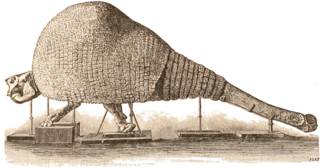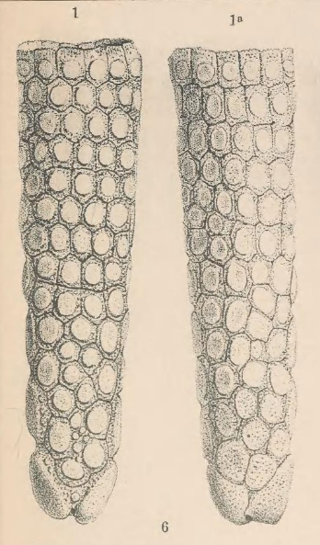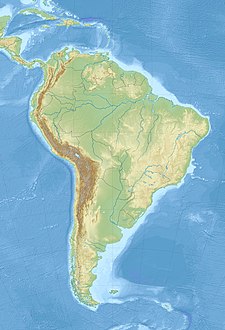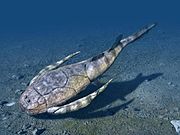
Glyptodonts are an extinct clade of large, heavily armoured armadillos, reaching up to 1.5 metres (4.9 ft) in height, and maximum body masses of around 2 tonnes. They had short, deep skulls, a fused vertebral column, and a large bony carapace made up of hundreds of individual scutes. Some glyptodonts had clubbed tails, similar to ankylosaurid dinosaurs.

Doedicurus is an extinct genus of glyptodont from South America containing one species, D. clavicaudatus. Glyptodonts are a member of the family Chlamyphoridae, which also includes some modern armadillo species, and they are classified in the superorder Xenarthra alongside sloths and anteaters. Being a glyptodont, it was a rotund animal with heavy armor and a carapace. Averaging at an approximate 1,400 kg (3,100 lb), it was one of the largest glyptodonts to have ever lived. Though glyptodonts were quadrupeds, large ones like Doedicurus may have been able to stand on two legs like other xenarthrans. It notably sported a spiked tail club, which may have weighed 40 or 65 kg in life, and it may have swung this in defense against predators or in fights with other Doedicurus at speeds of perhaps 11 m/s.

Glyptotherium is a genus of glyptodont in the family Chlamyphoridae that lived from the Early Pliocene, about 3.6 million years ago, to the Late Pleistocene, around 15,000 years ago. It had a wide distribution, living in the United States, Mexico, Guatemala, Costa Rica, Honduras, El Salvador, Panama, Venezuela, and Brazil. The genus was first described in 1903 by American paleontologist Henry Fairfield Osborn with the type species being, G. texanum, based on fossils that had been found in the Pliocene Blancan Beds in Llano Estacado, Texas, USA. Glyptotherium fossils have since been unearthed from many more fossil sites, from Florida to Colombia. Another species, G. cylindricum, was named in 1912 by fossil hunter Barnum Brown on the basis of a partial skeleton that had been unearthed from the Pleistocene deposits in Jalisco, Mexico. The two species differ in several aspects, including age, with G. texanum being from the older Early Pliocene to Early Pleistocene strata, whereas G. cylindricum is exclusive to the Late Pleistocene.

Hoplophorus is an extinct genus of glyptodont, a subfamily of armadillos. The only confidently known species was H. euphractus, found in Pleistocene deposits in Brazil, though fossils possibly from another species are known from Bolivia.

Panochthus is an extinct genus of glyptodont, which lived in the Gran Chaco-Pampean region of Argentina, Brazil, Bolivia, Paraguay and Uruguay during the Pleistocene epoch.

Glyptodon is a genus of glyptodont, an extinct group of large, herbivorous armadillos, that lived from the Pliocene, around 3.2 million years ago, to the early Holocene, around 11,000 years ago, in Brazil, Uruguay, Paraguay, Bolivia, Peru, Argentina, and Colombia. It is one of, if not the, best known genus of glyptodont. Glyptodon has a long and storied past, being the first named extinct cingulate and the type genus of the subfamily Glyptodontinae. Fossils of Glyptodon have been recorded as early as 1814 from Pleistocene aged deposits from Uruguay, though many were incorrectly referred to the ground sloth Megatherium by early paleontologists.

Eleutherocercus was a genus of glyptodonts that lived during the Late Miocene and Early Pliocene in South America. Fossils of the genus have been found in the Huayquerian Ituzaingó Formation and the Montehermosan Monte Hermoso Formation in Argentina.

Neosclerocalyptus was an extinct genus of glyptodont that lived during the Pliocene, Pleistocene, and Holocene of Southern South America, mostly Argentina. It was small compared to many Glyptodonts at only around 2 meters long and 360 kilograms.

Lomaphorus is a possibly dubious extinct genus of glyptodont that lived during the Pleistocene in eastern Argentina. Although many species have been referred, the genus itself is possibly dubious or synonymous with other glyptodonts like Neoslerocalyptus from the same region.
Kelenkura is an extinct genus of heavily armored mammals belonging to the subfamily Glyptodontinae, from the family Chlamyphoridae that contain most of the modern armadillos. It was a medium-sized South American animal, distantly related to Doedicurus. Fossils of this genus were recovered in the Arroyo Chasicó Formation and in the Loma de Las Tapias Formation of Argentina in rocks dating back to the Late Miocene epoch.
Proeuphractus is an extinct genus of xenarthran, related to the modern armadillos. It lived from the Early to the Late Miocene, and its fossilized remains were discovered in South America.
Eucinepeltus is an extinct genus of glyptodont. It lived during the Early Miocene, and its fossilized remains were discovered in South America.
Palaehoplophorus is an extinct genus of glyptodont. It lived from the Middle to the Late Miocene, and its fossilized remains were discovered in South America.
Urotherium is an extinct genus of Glyptodont. It lived from the Late Miocene to the Late Pliocene, and its fossilized remains were found in South America.
Neuryurus is an extinct genus of glyptodont. It lived from the Late Pliocene to the Early Holocene, and its fossilized remains were discovered in South America.
Comaphorus is a dubious extinct genus of glyptodont. It lived during the Late Miocene in Argentina, but only one fossil has ever been referred to the animal.
Asterostemma is an extinct genus of glyptodont. It lived during the Middle Miocene, and its fossilized remains were discovered in South America.

Cochlops is an extinct genus of glyptodont. It lived from the Early to Middle Miocene, and its fossilized remains have been found in South America.
Bolivartherium is an extinct genus of mylodontine mylodontid sloth that lived during the Late Miocene and Late Pliocene in what is now Venezuela. Fossils have been found in the Codore and Urumaco Formations of Venezuela.

Peltephilidae is a family of South American cingulates (armadillos) that lived for over 40 million years, but peaked in diversity towards the end of the Oligocene and beginning of the Miocene in what is now Argentina. They were exclusive to South America due to its geographic isolation at the time, one of many of the continent's strange endemic families. Peltephilids are one of the earliest known cingulates, diverging from the rest of Cingulata in the Early Eocene.



















